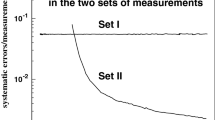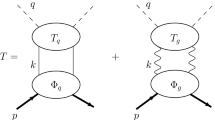Summary
In a previous paper we proposed a « hybrid » model for the large-energy, small-angle elastic scattering of hadrons, and used it to understand the structure in the angular distributions of proton-proton and proton-antiproton differential cross-sections. This model describes the scattering amplitude as the sum of an optical diffractive piece and a piece arising from the exchange of « absorbed » Regge poles; alternatively, it can be viewed as a specific prescription for calculating the effects of Regge cuts. In the present paper, we present some further results obtained from this hybrid model: we extrapolate our solutions for the pp amplitude to higher energies. We show how our model may be extended to deal with inelastic (or backward elastic) scattering, and consider processes which cannot be described by the single exchange of any known Regge trajectory, such as K−p backward elastic scattering. We explain why Regge cuts do not affect the presence or location of the dip in the π+p near-backward differential cross-section which is thought to arise from a nonsense zero of the nucleon trajectory. We predict that the differential cross-sections of elastic and of inelastic reactions should have the samet-dependence at large |t|, whether or not they do at small |t|.
Riassunto
In un articolo precedente si è proposto un modello « ibrido » per lo scattering elastico a grandi energie e piccoli angoli degli adroni e lo si è usato per comprendere la struttura delle sezioni d’urto pione-protone e protone-antiprotone nelle distribuzioni angolari. Questo modello descrive l’ampiezza di scattering come la somma di una parte ottica diffrattiva ed una parte derivante dallo scambio di poli di Regge « assorbiti »; in modo alternativo, il modello può essere preso come una prescrizione specifica per il calcolo degli effetti dei tagli di Regge. In questo articolo si presentano alcuni ulteriori risultati ottenuti da questo modello ibrido: si estrapolano le nostre soluzioni per l’ampiezza di pp ad più alte energie. Si dimostra come questo modello possa essere esteso fino a comprendere scattering anelastici (oppure scattering elastici con prodotti finali all’indietro), ed a considerare processi che non possono essere descritti dal singolo scambio di alcuna traiettoria di Regge nota, come è nel caso dello scattering elastico all’indietro K−p. Si spiega perchè i tagli di Regge non influiscano sulla presenza o la collocazione della pendenza nella sezione d’urto differenziale per urti quasi all’indietro di π+p, che si pensa derivi da uno zero senza senso della traiettoria del nucleone. Si predice che le sezioni d’urto differenziali delle reazioni elastiche e anelastiche dovrebbero avere la stessa dipendenza dat per valori di |t| grandi, qualunque sia il loro comportamento per |t| piccoli.
Реэюме
В предыд ушей статье мы предложили «гибридн ую» модель для малоу глового упругого рассеяния адронов п ри выских Энергиях, и испольэо вали ее для того, чтобы понять структуру угловых распреде лений для протон-пр отонных и протон-ан типротонных дифференц иальных поперечных сечений. Ёта модель опйсывает амплитуду рассеяния, как сумму оптической диффракцион ной части и части, воэник аюшей от обмена «поглош енным» полюсом Рэдже; с другой ст ороны, Эта модель мо жет быть рассмотр ена, как определен ный рецепт для вычисл ения Эффектов раэреэов Рэдже. В нас тояшей работе мы п риводим некоторые дальнейщие реэультаты, полученные иэ Этой гибридной модели: мы Экстрапол ируем нащи рещения для рр амплиту ды для высоких Энергий. Мы покаэывае м, как наща модель мож ет быть расщирена для рассмотрения неупругого (или обратного упругого) рассеяния, и иэучения процессов, которые не могут быть описаны с помошью о тдельного обмена любой иэвестной траектори ей Редже, такого как K−p обратное упругое рассеяние. Мы общясняем, почему раэреэы Рэдже не влияют на присутств ие или локалиэац ию провала в π+p дифференц иальном поперечно м сечении вблиэи нап равления наэад, что, думается, воэникает от бессмысле нного нуля нуклонной траектор ии. Му предскаэы ваем, что дифференц иальные поперечн ые сечения для упругих и неупругих реакций должны им еть ту же самую эави симость отt при больщ их |it|, вне эависймо сти от того, имели они или нет одинаковую эависим ость при малыхt.
Similar content being viewed by others
References
V. Franco:Phys. Rev. Lett.,18, 1159 (1967).
R. J. Glauber: inLectures in Theoretical Physics, vol.1 (New York, 1959), p. 315.
G. Cohen-Tannoudji, A. Morel andH. Navelet:Nuovo Cimento,48 A, 1075 (1967).
V. N. Gribov:Sov. Phys. JETP,26, 414 (1968).
C. B. Chiu andJ. Finkelstein:Nuovo Cimento,48 A, 820 (1967).
A. A. Anselm andI. T. Dyatlov:Phys. Lett.,24 B, 479 (1967).
R. C. Arnold:Phys. Rev.,153, 1523 (1967).
L. Durand III andR. Lipes:Phys. Rev. Lett.,20, 637 (1968).
J. V. Allaby et al.:CERN Topical Conference, vol.1 (1968), p. 580.
Frautschi andMargolis (private communication) have recently analysed pp scattering in an eikonal model with a Pomeranchukon of nonzero slope, thus achieving an energy-dependent amplitude without invoking secondary trajectories. Since much of the structure can be understood in terms of the general properties of the multiple-scattering series (see for example, ref. (8)), their calculation is somewhat similar to ours.
J. Orear, R. Rubinstein, D. B. Scarl, D. H. White, A. D. Krisch, W. R. Frisken, A. L. Read andH. Ruderman:Phys. Rev.,152, 1162 (1967).
R. Rubinstein,et al.:CERN Topical Conference, vol.1 (1968), p. 571.
E. W. Anderson, E. J. Bleser, G. B. Collins, T. Fujii, J. Menes, F. Turkot, R. A. Carrigan jr.,R. M. Edelstein, N. C. Hien, T. J. McMahon andI. Nadelhaft:Phys. Rev. Lett.,16, 855 (1966).
C. B. Chiu andJ. Stack:Phys. Rev.,153, 1575 (1967).
A. Ashmore, C. J. S. Damerell, W. R. Frisken, R. Rubinstein, J. Orear, D. P. Owen, F. C. Peterson, A. L. Read, D. G. Ryan andD. H. White:Phys. Rev. Lett.,19, 460 (1967).
H. Brody, R. Lanza, R. Marshall, J. Niederer, W. Selove, M. Shoket andR. Van Berg:Phys. Rev. Lett.,16, 828 (1966).
K. J. Foley, S. J. Lindenbaum, W. A. Love, S. Ozaki, J. J. Russell andL. C. L. Yuan:Phys. Rev. Lett.,11, 425 (1963).
Author information
Authors and Affiliations
Rights and permissions
About this article
Cite this article
Chiu, C.B., Finkelstein, J. The hybrid model: Further results. Nuovo Cimento A (1965-1970) 59, 92–106 (1969). https://doi.org/10.1007/BF02756348
Received:
Published:
Issue Date:
DOI: https://doi.org/10.1007/BF02756348




